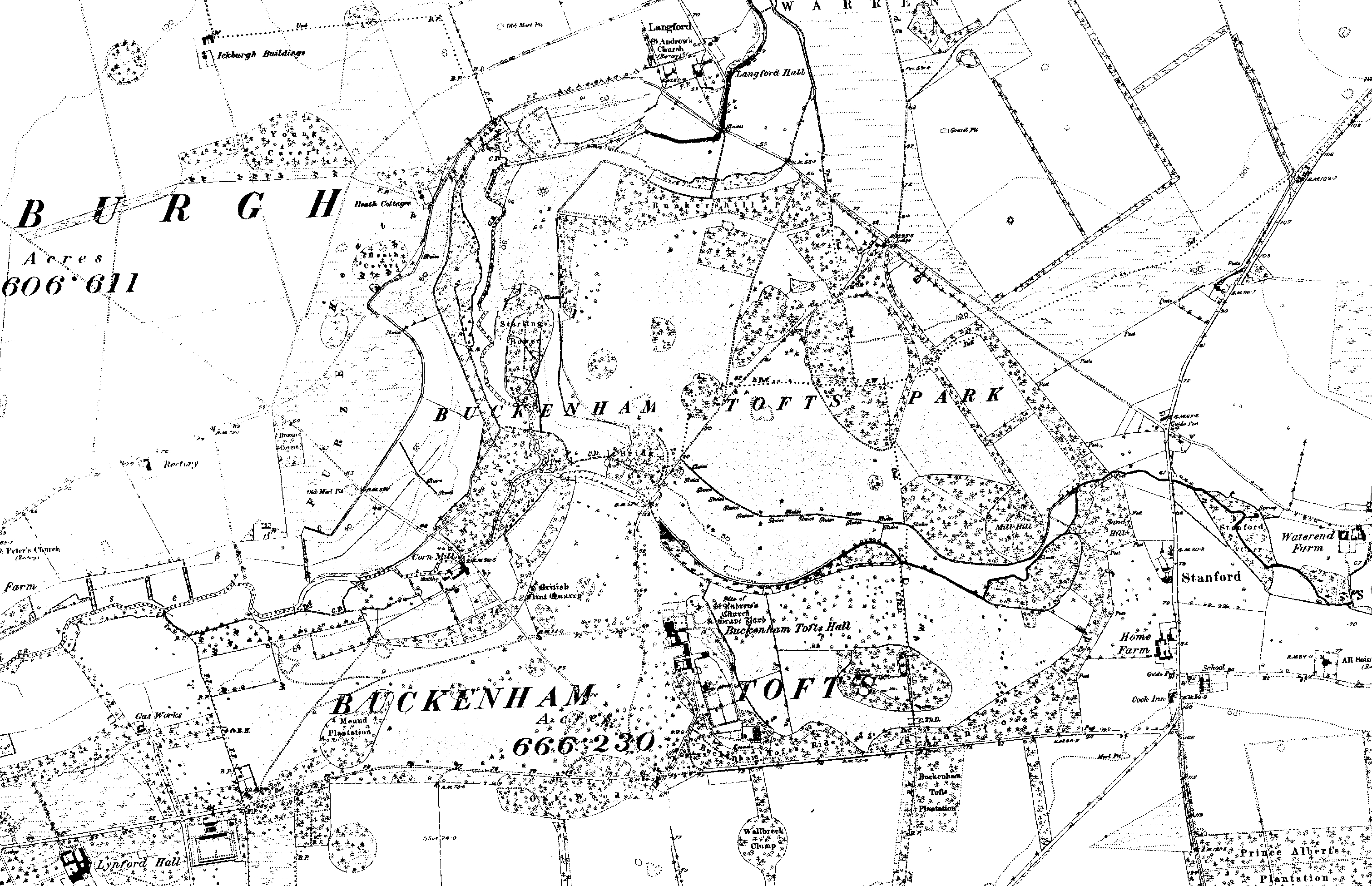Lynford Hall
The Owners
In his Essay Towards a Topographical History, Francis Blomefield describes the various changes of ownership of the Lynford estate from the Domesday Book through to the early 19th century, including ownership by the Dukes of Norfolk, granted and revoked by different monarchs when the family were in or out of favour. According to Blomefield, the estate was sold by Philip, Earl of Arundel in 1603, to Francis Mundford of Feltwell. The Mundford family sold the property in 1643 to a Mr Turner, a lawyer and it passed to his son, Sir Charles Turner. In 1717 the property was bought by James Nelthorpe from Sir Charles Turner.
The estate passed to George Eyres in 1805 and then to Sir Richard Sutton in 1827. The 18th century house and grounds were sold to S. Lyne Stephens in 1856. Mrs Lyne Stephens remained in the house following her husband’s death in 1860. The hall was restored, after damage by fire in 1928, by James Calder in the 1930s before being sold to the Forestry Commission. It returned to private ownership in the 1960s and has been run as a hotel since then.
The House
The Old Hall was originally built around 1500, and was used as a farmhouse until the 18th century. Following the change of ownership in 1717, a second hall was built between 1717 and 1720, the Old Hall continuing to be used as a farmhouse. Further alterations were made, including those by C.R. Cockrell in 1827, when Sir Richard Sutton bought the property. The various alterations made to the hall were concealed by an outer casing of white brick. The 18th century building was demolished in 1863.
The current building was completed in 1862 on a site around 400m north of the 18th century house. The house was designed in a Jacobean Renaissance style by architect William Burns. According to the Gardeners’ Chronicle the builder was a Mr Smith of Pimlico with the contract for the shell being for £44,000 and the overall cost some £100,000. Following a fire in 1928, the 19th century house was reduced in size and refurbished with only the basement remaining of the block to the east of the main hall.
The Gardens
The gardens around the hall built by James Nelthorpe in the 18th century included gardens along with plantations and canals, according to Blomefield. Faden’s map shows the hall standing in what may be the pleasure grounds, with woodland to the west.
Formal gardens for the hall completed in 1863 were designed by William Andrews Nesfield, with low balustrades enclosing a terraced garden and parterres. The Gardeners’ Chronicle reports in 1867 that the pleasure grounds and flower gardens extend to around 23 acres. The report records the centre piece of the formal garden, a statue of two bulls in marble depicted in conflict, describing it as a “magnificent mistake”. A narrow lake was already in existence when the estate was sold in 1856 and was altered into a more serpentine form, with a long canal, known as the Long Water created to the west. Later additions to the gardens in the early 20th century included a Japanese garden created on an island at the eastern end of the lake.
The Park
The 18th century park shown on Faden’s map extended to around c.35 hectares. By the time of the sale in 1856 the park had increased to c.88 hectares and was extended to c.105 hectares in the mid 19th century. A significant addition to the park in the 19th century was an avenue of Wellingtonia, planted running south west from the hall. The Gardeners’ Chronicle in 1867 reports that the Wellingtonia were fine, healthy plants, at this time some 5 – 10 feet high but by 1884 a further article on Lynford noted that the avenue of Wellingtonia had not grown as well as expected since planting, due to the poor soil. A detached walled kitchen garden was also built in the 19th century, around 300 metres to the east of the hall.
What survives in the modern landscape?
What remains of the 19th century park is mostly owned by the Forestry Commission today, with areas of woodland and plantations around the hall and gardens. To the east of the hall is an arboretum, also planted by the Forestry Commission. The avenue of Wellingtonia survives although the trees have been depleted by disease.
The hall is currently a hotel and the outline of the formal gardens created by Nesfield can still be seen to the south of the building, including the terraces and surrounding balustrade. The lake and Long Water remain, within the grounds of the hotel. The kitchen garden lies to the east of the present day arboretum and has recently been partially restored.
Where to find out more
- Lynford Hall on the Norfolk Heritage Explorer
- Historic England Heritage List
- The Gardeners’ Chronicle and Agricultural Gazette 3 August 1867 pp 810-811
- The Gardeners’ Chronicle and Agricultural Gazette 10 August 1867 pp 834-835
- The Gardeners’ Chronicle 20 September 1884 pp 359-360
- Faden’s Map of Norfolk
- Francis Blomefield, 'Hundred of Grimeshou: Bukenham-Parva, or Little-Bukenham', in An Essay Towards A Topographical History of the County of Norfolk: Volume 2 (London, 1805), pp. 263-266. British History Online
- T. Williamson, P. Dallas and R. Last (2013) Norfolk Gardens and Designed Landscapes, Windgather Press.
- Richard Wilson and Alan Mackley (2000) Creating Paradise: The Building of the English Country House 1660 – 1880, Hambledon and London, London and New York.
